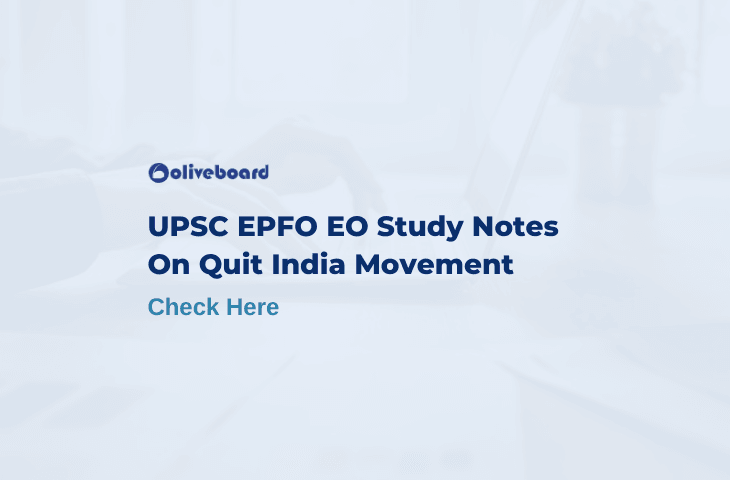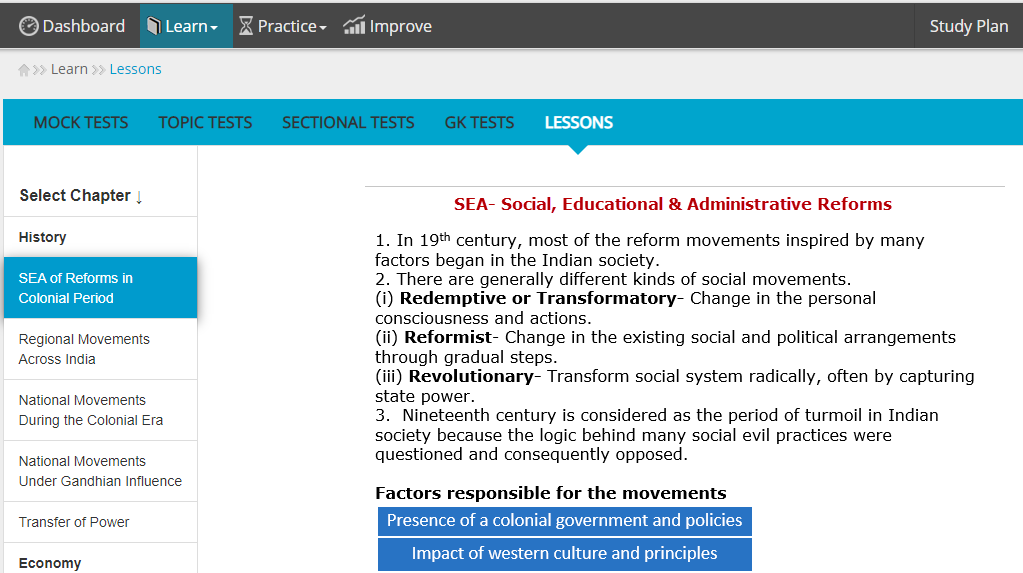When it comes to modern history there are certain topics that pull our attention and are a symbol of major significance. One such movement is The Quit India Movement. This event had a major impact on the uniting of Indians to remove the British power out of our country and gain complete freedom. This makes it all the more important from the exam point of view especially exams like UPSC EPFO. In this article, we will be providing you with The Quit India Movement Study Notes to help you prepare for the topic.
Register Here & Take A Free Mock Test For UPSC EPFO EO
Let’s dive in to know all about it.
1. The Quit India Movement Study Notes – Modern History
1.1 Introduction
The Quit India Movement also referred to as the August Movement, was a movement launched during the Bombay Session of All India Congress Committee by Mahatma Gandhi on 8th August 1942.
This was the time of the Second world war when India decided to end the British rule in India and they dreamt of a free India.
When Mahatma Gandhi gave his Do or Die speech in the Gowalia tank Maidan in Bombay, it spread like fire, and even though the British were at war they could not stand this speech, and they sent the Indian leaders overnight into the prison without any trial. The British had the support of the Viceroy’s Council (which had a majority of Indians), of the All India Muslim League, the princely states, the Indian Imperial Police, the British Indian Army, the Hindu Mahasabha, and the Indian Civil Service
At that point in time, the Quit India Movement was suppressed by the Britishers. The British refused to grant immediate independence, saying it could happen only after the war had ended.
1.2 Quit India Movement – How It All Started?
When Germany and Britain went into war in 1939, India without having a choice became a party to the war by being a constituent component of the British Empire. Following this declaration, the Congress Working Committee at its meeting on 10 October 1939, passed a resolution condemning the aggressive activities of the Germans.
Responding to this declaration, the then Viceroy issued a statement wherein he claimed that Britain is waging a war driven with the intention of strengthening peace in the world. Although this was not well received by the people around the world as the situations demeaned the statements made by the officials.
Prepare For UPSC EPFO EO With Oliveboard. Start Now With A Free Mock Test!
At that point, the high command issued a statement and the prominent Congress leaders were asked to resign with immediate effect. Since the Muslim community under the leadership of Mohammad Ali Jinnah also did not support this Quit India Movement, they later came with a slogan of wanting a separate homeland name, Pakistan.
This motto was given by Mohammad Ali Jinnah during his presidential run speech.
In the meanwhile, crucial political events took place in England. Chamberlain was succeeded by Churchill as prime minister and the Conservatives, who assumed power in England, did not have a sympathetic stance towards the claims made by the Congress. In order to pacify the Indians in the circumstance of the worsening war situation, the Conservatives were forced to concede some of the demands made by the Indians.
In 1942, following the discussion with Lord Cripps, the Cripps mission came into light. The purpose of the mission was to negotiate with the Indian National Congress a deal to obtain total co-operation during the war, in return for progressive devolution and distribution of power from the crown and the Viceroy to an elected Indian legislature.
But the mission failed and it also played an important role in the rising of the Quit India Movement.
Topper took the test & scored 105/120. Can You Beat The Score?
2. Opposers of The Movement – Quit India Movement Study Notes
Although the movement was to gain freedom from British rule and gain complete overnight independence, it did not have full support it would have needed at that point in time. There were many Indian subordinates and parties that opposed the movement due to some of the other reasons.
Here is a list of a few of the opposers;
2.1 Hindu Mahasabha
Hindu Mahasabha officially boycotted the movement at an open front. That time leader of the Hindu Mahasabha Vinayak Savarkar even went to such an extent where he instructed the mahasabhaites to stick to their post and may it be in legislative body, municipal corporation, or army. They were not allowed to join the quit India movement at any cost.
Immense persuasions were done and multiple people approached the leader, Vinayak Savarkar, enlightening him on how it is crucial for India sabhas to be a part of this movement. Later after multiple persuasions, they agreed to be a part of this movement.
2.2 Princely States of India
The movement had less support in the princely states, as the princes were strongly opposed and funded the opposition.
The Indian nationalists had very little international support. They knew that the United States strongly supported Indian independence, in principle, and believed the U.S. was an ally.
However, after Churchill threatened to resign if pushed too hard, the U.S. quietly supported him while bombarding Indians with propaganda designed to strengthen public support of the war effort. The poorly run American operation annoyed the Indians.
2.3 Rashtriya Swayamsewak Sangh
RSS always kept its distance from the All India Congress. This made the Congress-led anti-British Indian independence movement weaker. They refused to join the Quit India Movement.
Register Now & Get 10% Instant Off On Mock Test & Study Notes
3. Suppression of The Quit India Movement
One of the important achievements of the movement was keeping the Congress party united through all the trials and tribulations that followed. The British, already alarmed by the advance of the Japanese army to the India-Burma border, responded by imprisoning Gandhi.
The British swiftly responded with mass detentions. Over 100,000 arrests were made, mass fines were levied and demonstrators were subjected to public flogging. Hundreds of civilians were killed in violence many shot by the police army. Many national leaders went underground and continued their struggle by broadcasting messages over clandestine radio stations, distributing pamphlets, and establishing parallel governments.
The Congress leadership was cut off from the rest of the world for over three years.
4. UPSC EPFO Enforcement Officer 2020 – Complete Preparation
1. 10 Mock Tests for EPFO EO 2020 in the latest pattern with detailed solutions
2. Summary Notes for all sections (except Quant, Eng)
- Indian Freedom Struggle (Click Here For Notes)
- Indian Polity and Economy (Click Here For Notes)
- General Accounting Principles (Click Here For Notes)
- Industrial Relations and Labor Laws (Click Here For Notes)
- General Science and Knowledge of Computer Applications (Click Here For Notes)
- Social Security in India (Click Here For Notes)
4.1 Here’s a Sneak Peek in The UPSC EPFO EO Notes
Get Complete Study Notes For UPSC EPFO EO Here
That brings us to the end of this article for the Quit India Movement Study Materials. Now you can get complete study notes for the preparations of the enforcement officer exam on Oliveboard along with the Mock Tests that are specially designed for the UPSC EPFO, keeping in mind the pattern and difficulty level.

Hello there! I’m a dedicated Government Job aspirant turned passionate writer & content marketer. My blogs are a one-stop destination for accurate and comprehensive information on exams like Regulatory Bodies, Banking, SSC, State PSCs, and more. I’m on a mission to provide you with all the details you need, conveniently in one place. When I’m not writing and marketing, you’ll find me happily experimenting in the kitchen, cooking up delightful treats. Join me on this journey of knowledge and flavors!

